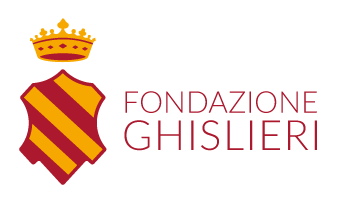THE CASTLE OF LARDIRAGO
The Castle is part of an architectural complex located in the Municipality of Lardirago (about 7 km north of Pavia, near the provincial road Pavia-Melegnano), consisting of the Castle itself, its Ricetto and the nearby Cortegrande farmhouse.
ORIGIN OF THE PROPERTY
In 1569 Pope Pius V, with the Edict “In supereminenti sedis apostolicae” have passed the administrative prerogatives to the Collegio Ghislieri. It has remained so until today, through Spanish domination, the government of the House of Austria, the French Revolution and after the unification of Italy.
In the past the Castle has carried out functions of defence, aristocratic residence, deposit and custody of crops, as well as administration of the surrounding territory. These functions are no longer relevant today, and after the last World War the majestic building gradually went into disuse. Consequently, the Administration of the Collegio has decided that the most appropriate use today of the Castle is for cultural purposes, as Ghislieri does since always.
THE ARCHITECTURAL COMPLEX
The Castle is a typical building of the Visconti period, built in the 14th century to complete pre-existing fortified structures dating back to the 11th and 12th centuries. The Ricetto, located south of the Castle, also dates back to the 14th century. To the east of the Castle there is the Cascina Cortegrande, dating back to the 16th and 17th centuries, composed of several buildings facing a large quadrangular courtyard, according to the traditional scheme of the Lombard farmhouse.
THE CASTLE
The building is a complex construction, composed of several elements built in different times. The ground floor of the tower encloses the Romanesque Chapel of San Gervasio (dated to the 11th century), which can be accessed directly from the inner courtyard.
A peculiarity of the Chapel, the ancient heart of the Castle, consists in the fact that the paintings are precisely incorporated into successive building stratifications (but not for this reason of lesser historical and artistic importance) and bringing to light the former would entail the demolition of the latter.
Another particular building structure is the staircase, or rather the helicoidal ramp, located within the southern side of the Castle.
It is possible to suppose that originally it allowed access to the basement cellars, to the large rooms on the various floors of the western wing of the Castle. The inclined plane of the helicoidal ramp, with a gentle slope, could also be walked by horses and small carts.
PROJECT AND RESTORATION STEPS
The Collegio Ghislieri has been restoring the entire building complex for about a decade. The general project foresees the renovation of the Castle as a venue for many cultural, congress and exhibition activities. The Ricetto is destined for guest quarters. In the Cascina Cortegrande there will be accommodation and collective spaces for the participants of the activities carried out in the Castle.
The restoration works have so far led to the redevelopment of the east wing of the Castle. The recovery of a very complex construction, whose structure reflects a millennium of history, has necessarily involved difficult architectural choices, which have preserved and enhanced the imprints of the past, but at the same time have allowed the use of the building according to the most current needs. The renovated halls and classrooms now host conferences, seminars, advanced training courses, concerts and various events.
The Foundation’s commitment is to continue the restoration work on the entire architectural complex, aimed at creating a prestigious structure, particularly suitable as a venue for highly qualified projects.
DESTINATION OF USE
The reuse of the architectural complex of Lardirago, located in a strategic area near the border between the provinces of Pavia and Milan, will enhance the historical heritage of Ghislieri.













